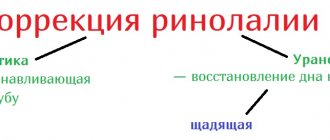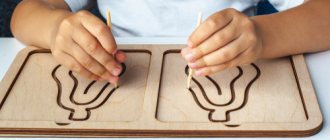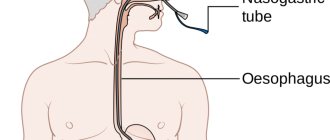Signs and manifestations
In early childhood, babies perform many unconscious actions. For example, babies open their mouths slightly when they move their arms and legs, but this goes away before they reach one year of age. The older the child, the fewer accompanying movements he makes. This tendency is considered normal.
There are age norms for the amount of synkinesis associated with fine motor skills:
- 6 years - up to ten reflex movements;
- 7 years - about six;
- 8 years - five, etc.
Today's children have greater motor retardation than their predecessors because today's lifestyle requires less manual labor. Synkinesis also develops as an independent symptom of damage to the nervous system or its parts.
Opening hours: 8:00 to 20:00
Telephone
Sign up
Today's children have greater motor retardation than their predecessors because today's lifestyle requires less manual labor. Synkinesis also develops as an independent symptom of damage to the nervous system or its parts.
Children's synkinesis
Quite simple tests help make sure that everything is not all right with the baby. They can be made at home.
A child with synkinesis either cannot perform at all or incorrectly performs seemingly elementary exercises. So, let's check it out?
- Ask your child to consistently connect the thumb with all the fingers on the same hand.
- Show your baby the “ring” combination by connecting your thumb and index finger, and then ask him to do the same first on one hand, then on the other. At 4 years old, you can still help the child by explaining to him which fingers should be involved in the work. Then it will be more difficult to do.
- Show your baby the “goat” combination on your hand by extending your index finger and little finger forward from your fist. Ask him to do the same on one and then on the other hand. Make sure that the “right” fingers are involved in the work: so that the thumb does not go to the side and that the baby does not help himself with the other hand. You can discuss in advance with a 4-year-old child which fingers will participate in the game.
- Show the child the “victory” sign on one hand - the index and middle fingers raised up. Ask him to repeat this gesture first on one hand, then on the other. Make sure your fingers are straight when performing the test.
- Here is a test that allows you to check your child’s interhemispheric coordination. To do this, pour white and red beans into a bowl. Ask your child to pick up white beans with his left hand and red beans with his right hand. This must be done simultaneously, placing the beans on two different plates.
Strictly speaking, synkinesis is involuntary cooperative movements. They are present in almost every person.
For example, when we walk, we wave our arms or, when we touch up our eyelashes, we stick out our tongue out of zeal. But this is synkinesis, which does not interfere with our lives.
The problem with childhood synkinesis is that the child requires much more effort to learn than his peers. The energy that could be spent on attention and performance is instead used to compensate for additional and completely unnecessary movements. For example, a baby draws and at the same time actively moves his tongue. Or during some activity his lips suddenly begin to move.
When a child’s tongue works together with his hand, it means that one center in his brain is responsible for both three fingers and the tongue. And this center takes in three times more energy than it should. One center in the brain may integrate fingers and vision. And then, simultaneously with the work of the fingers, the eyes strain, and the child incorrectly copies the tasks from the board. This is not because he is inattentive. As soon as he raises his head to look at what is written on the board, his eye stops working “correctly.” He randomly snatches only pieces from what the teacher wrote on the blackboard. There was a case when a child was brought to a surgeon for a consultation, whose legs began to hurt during classes in the first grade. The most surprising thing is that the cause was again synkinesis. As soon as the child took the pen and began to write, the muscles in his legs tensed and the baby’s legs cramped.
Why is it so important to hold a pencil and pen correctly? The answer is as simple as two: this is how we spend the least effort on writing, without straining our hand. This means that a lot of energy is saved for other activities: for example, you can simultaneously listen to explanations or copy from the board. And if you take the pencil incorrectly and the elbow hangs in the air, then the child will spend enormous effort just to keep his hand in the desired position.
A child with synkinesis gets tired much faster and his performance decreases. Yes, this is understandable: after all, his energy reserve is eaten up by the movements accompanying writing, which he does not need at all! If the baby is tired, it means that he perceives little and needs to immerse himself in order to accumulate energy. What if there is a lesson going on at this time? Techniques of specialists for working with such children are usually based on motor exercises and drug treatment.
Corrective work
To overcome synkinesis you need a complex effect. These are exercises to improve general motor skills and relax muscle tone. Therefore, such patients are often recommended to take up swimming, because it has a beneficial effect not only on motor activity, but also on the nervous system.
Children with synkinesis attend exercise therapy classes and undergo courses of therapeutic massages prescribed by the doctor. If they manifest themselves in articulatory and facial motor skills, then a course of speech therapy massage is added. It should only be performed by a speech therapist who has completed special courses. At home, you can do simple self-massage, which also has a beneficial effect on the facial and articulatory muscles.
For dysarthria, drug treatment is prescribed. It not only stimulates the work of speech centers, but also affects the state of muscle tone.
The sooner parents seek advice from a specialist, the more effective the correction work will be. Overcoming synkinesis has a beneficial effect not only on speech activity, but also on the nervous system and muscle tone.
Physiological motor synkinesis
Motor synkinesis can be natural or physiological. They are considered conditioned reflexes that gradually disappear with age. But some of it remains at the level of automaticity.
Physiological synkinesis is a manifestation of primitive motor skills, caused by insufficient development of the motor and pyramidal centers of the brain. Doctors around the world are sounding the alarm. In the last decade, the number of people who, by the age of 20–25 years, retain sufficient development of motor function of the brain has been increasing. This is due to the fact that many types of housework have become automated. Nowadays, rarely does anyone wash things by hand, sew, knit, embroider, or do carpentry. And all these activities developed fine motor skills of the hands. The result now is that motor physiological synkinesis can occur in adults. It's very difficult to fix this. It is necessary to undergo a long rehabilitation course.
Clinical picture
The main symptoms of the development of synkinesis:
- increased muscle resistance during active movement;
- the appearance of rhythmic contractile movements of individual muscles;
- disturbance of facial movements;
- reflex rhythmic twitching of the feet;
- twitching of the affected limb due to mechanical or thermal influence;
- increased intensity of tendon reflexes;
- the presence of increased muscle tone upon palpation.
Reasons for violation
There are several causes of this syndrome:
- transmission of excitation irradiation to neighboring neurons;
- facilitating effect of the reticular formation on the elements of the spinal cord;
- the tendency of the regenerating facial nerve to branch;
- central nervous system disorder;
- disruption of the peripheral central nervous system;
- presence of spinal injuries;
- stroke;
- disturbance in the formation of facial movements;
- the occurrence of spastic ataxia;
- circulatory disorders in the brain;
- the presence of severe traumatic brain injuries;
- the occurrence of tumors and other neoplasms;
- the presence of inflammatory processes in the body;
- abnormal increase in general muscle tone.
Basic diagnostic methods
Diagnosis in case of synkinesis is carried out in the following ways:
- Visual inspection . In this case, the patient must be examined by a neurologist who monitors voluntary movements.
- Carrying out magnetic resonance imaging.
- Fluoroscopy . It consists of illuminating the entire body in both horizontal and vertical positions.
- Electromyography of skeletal muscles . This is a method for diagnosing damage to the neuromuscular system, which consists of recording the electrical activity of skeletal muscles. Even in the presence of primary muscle damage, a decrease in the amplitude of oscillations is already noted.
- Comprehensive test of leg reflexes . Diagnosis takes place in the supine position. When you lift your leg up, tension occurs on the sciatic nerve. Therefore, if involuntary movement of other joints or limbs is observed, this indicates the presence of one of the types of synkinesis.
- Electroencephalography . It consists of checking the functional state of the brain. Allows you to determine the presence of nerve spasms.
- Carrying out neurosonography .
Since synkinesis is very often accompanied by a number of other diseases, diagnosis cannot be quick and unambiguous. In addition to the above research methods, the patient must undergo an examination by an otolaryngologist, neurosurgeon, dentist and ophthalmologist.
Modern treatment of synkinesis
Before starting treatment for synkinesis, it is necessary to conduct a series of diagnostic examinations and establish the exact cause of the appearance of unpleasant symptoms. For diagnosis, X-rays, MRI, CT, vascular ultrasound, electromyography, neurography, EEG and many other methods are used.
To make a diagnosis, you need to contact a neurologist. This specialist will conduct an examination and prescribe additional examinations as necessary. After making an accurate diagnosis, the doctor develops an individual treatment plan that takes into account the potential cause, the general condition of the patient, and the degree of advanced disease.
In our manual therapy clinic, treatment of synkinesis is carried out using absolutely safe and effective techniques. We have accumulated extensive experience in the complete restoration of the functions of the central and nervous system.
We use the following types of treatment in treatment:
- manual traction of the spinal column, if involuntary muscle contractions are associated with pathologies of its tissues;
- reflexology – due to acupressure, the hidden reserves of the human body are activated, tissue regeneration processes are launched;
- osteopathy improves microcirculation of blood and lymphatic fluid in the affected areas;
- therapeutic exercises and kinesiotherapy allow the formation of correct neural connections and strengthen the muscular frame of the human body;
- physiotherapy improves metabolic processes in tissues;
- massage relieves excess tension and promotes the correct conduction of nerve impulses.
If you need safe and effective treatment for synkinesis, we suggest you make a free appointment with a neurologist right now. The doctor will conduct an examination and give individual recommendations for complex therapy. Fill out the registration form located further down the page.








